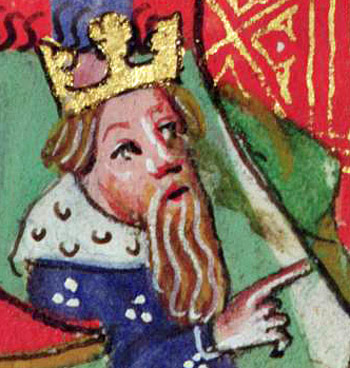Roland and Vernagu
General Information
Plot Summary

After a Saracen King of Spain attacks the Patriarch of Jerusalem, the Emperor of Constantinople prays for guidance. An angel instructs him to send to Charlemagne, King of France and Emperor of Rome, to help them in battle. Afterwards, Charlemagne refuses Constantine’s offer of treasure, but accepts his gift of important Passion relics, whose authenticity is proved by a heavenly light. He then travels to Gascony, where a vision of St James the Apostle urges him to conquer Spain and Portugal, where the saint is buried.
Charlemagne’s army lays siege to Pamplona for six months until, in response to his prayers, the walls miraculously collapse. They move on through Spain, conquering many towns, until they reach Logrono, which holds out against their siege for a year. However, once again the walls are miraculously breached, and Charles curses the city, along with others, which remain uninhabitable to this day. Through God’s help, Charlemagne achieves more in Spain than any Christian before him, destroying the country’s most powerful idols. He uses the treasure that he wins to build churches throughout Spain and France, dedicating several to St James.
As the army rests, another miracle punishes a man who does not execute the will of a knight as instructed. Then the troops return to Pamplona, as Charlemagne’s appearance, habits and fear of treason are described. While they are there, word arrives that the Sultan of Babylon has sent Vernagu, a fearsome giant, to the Spanish town of Nájera. Many of the Peers try to confront him, but Vernagu mockingly carries them back to their castle, demanding more worthy opponents. Eventually, Charlemagne unwillingly allows Roland to challenge the giant.
The pair takes to the field and fights a gruelling duel that lasts until night, when they agree to part and rest. The next day they resume, using staves and then stones as weapons. In the evening, the exhausted Vernagu asks Roland’s permission to sleep. The knight agrees and, when the giant begins to snore, places a stone beneath his head. Vernagu awakes and is astounded by the kindness. The two begin to talk and, when Roland mentions his belief in Christ, Vernagu is intrigued and asks for more information. Prompted by the giant’s questions, Roland explains the tenets of his faith with simple analogies, covering the immaculate conception, the Passion and the harrowing of hell, the Trinity, the incarnation and the resurrection. When he is satisfied, Vernagu suggests that they continue their fight to test whose faith is correct.
Roland’s staff breaks and he prays for help. An angel instructs him to slay Vernagu, who is so wicked that all the clergy alive could not absolve his sins. Roland attacks with renewed vigour, cutting off his enemy’s left arm. The giant continues to fight, but the knight gains the upper hand, striking the pagan with Durendale until he cries out to Mohammed and Jupiter to save him. Laughing, Roland cuts off his opponent’s head to take to Charlemagne and praises God and Mary. The French celebrate, but word of Vernagu’s death reaches Otuel, another Saracen knight.
From: S.J. Herrtage, The Taill of Rauf Coilyear, Roland and Vernagu and Otuel, EETS 39 (London, 1882)
Manuscript: Edinburgh, National Library of Scotland, Advocates 19.2.1 (Auchinleck MS)
Manuscripts
Click a title below to search for all romances in that manuscript.